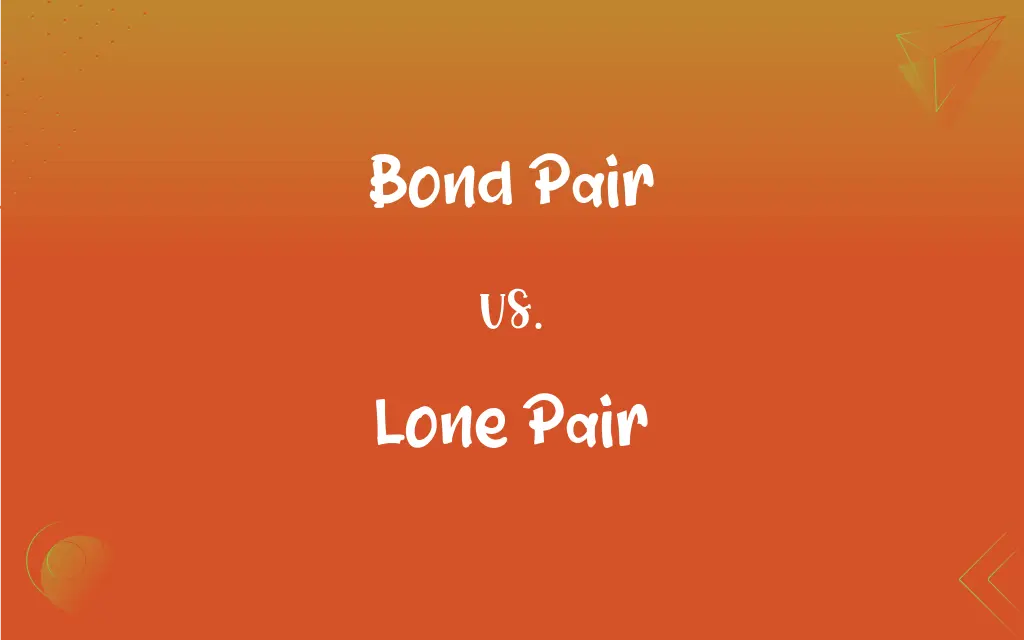Bond Pair vs. Lone Pair: What's the Difference?
Edited by Aimie Carlson || By Harlon Moss || Updated on October 17, 2023
Bond pair refers to a pair of electrons shared between atoms; lone pair refers to a pair of electrons not involved in bonding but reside on an atom.

Key Differences
A bond pair consists of two electrons that are shared between two atoms to form a covalent bond. It is the primary means by which atoms achieve a stable electronic configuration. When two atoms come close enough, they can share a pair of electrons, allowing both to count the shared electrons in their valence shell, which usually results in enhanced stability.
A lone pair, on the other hand, refers to a pair of valence electrons that are not involved in covalent bonding. Instead, they remain localized on an individual atom. These electrons can be found in the outer shell of atoms, and while they don't contribute to the formation of a bond, they do play a significant role in the molecular geometry and properties.
Bond pair electrons are involved directly in the bond formation between two atoms. The energy of these electrons is lower, meaning they are more stable because they're involved in the bonding process. As these electrons are shared, they hold the atoms together, forming a molecule.
Lone pair electrons, while not participating in bond formation, still have an influence on the molecular structure. They repel other electron pairs, including bond pairs, leading to deviations in expected bond angles in molecular geometries. For example, in water (H2O), the two lone pairs on the oxygen atom push down the hydrogen atoms, resulting in a bent structure.
Comparison Chart
Nature of Electrons
Electrons shared between atoms.
Electrons not involved in bonding.
ADVERTISEMENT
Role in Molecular Geometry
Directly determines bond formation.
Influences molecular geometry by repulsion.
Energy Level
Typically lower energy (more stable).
Higher energy compared to bond pair.
Involvement in Bonding
Directly involved in bond formation.
Not involved in bond formation.
Effect on Properties
Contributes to molecule's stability.
May contribute to reactivity, polarity, and other properties.
Bond Pair and Lone Pair Definitions
Bond Pair
Bond pairs contribute to the overall stability of a molecule.
The triple bond in nitrogen (N2) contains three bond pairs, making it very stable.
ADVERTISEMENT
Lone Pair
Lone pairs can participate in certain chemical reactions.
The lone pair on ammonia's nitrogen makes it a base when reacting with acids.
Bond Pair
Bond pairs result from the overlap of atomic orbitals from two different atoms.
In methane (CH4), each C-H bond has one bond pair.
Lone Pair
A lone pair consists of two valence electrons on an atom not used in bonding.
Water (H2O) has two lone pairs on the oxygen atom.
Bond Pair
A bond pair's presence indicates a covalent connection between atoms.
The single bond in hydrogen chloride (HCl) is due to one bond pair.
Lone Pair
Lone pairs occupy space in the electron cloud and repel other electron pairs.
In pyramidal shaped NH3, the lone pair repels the bond pairs, determining its geometry.
Bond Pair
Bond pairs act as the glue, holding atoms together in a molecule.
The double bond in oxygen (O2) has two bond pairs.
Lone Pair
The presence of a lone pair can influence molecular shape and polarity.
The bent shape of water (H2O) is influenced by its lone pairs.
Bond Pair
A bond pair is a set of two electrons that are shared between two atoms in a covalent bond.
In a hydrogen molecule (H2), the bond pair is shared between the two hydrogen atoms.
Lone Pair
Lone pairs remain localized and don't contribute directly to atom-atom connections.
Ammonia (NH3) has a lone pair on the nitrogen atom.
FAQs
Why do lone pairs affect molecular geometry?
Lone pairs repel other electron pairs, causing deviations in expected bond angles.
How does a lone pair differ from a bond pair?
A lone pair consists of two electrons not involved in bonding, while a bond pair is shared between atoms.
Do bond pairs influence molecular shape?
Yes, bond pairs directly determine the connections between atoms and influence molecular geometry.
How many electrons make up a bond pair?
A bond pair consists of two electrons.
How does the number of bond pairs affect bond strength?
Multiple bond pairs, as in double or triple bonds, typically result in stronger bonds compared to single bonds.
What is a bond pair?
A bond pair is a set of two electrons shared between two atoms in a covalent bond.
Are bond pairs more stable than lone pairs?
Typically, bond pairs have lower energy and are more stable since they're involved in bonding.
Can lone pairs become bond pairs?
Yes, under certain conditions, lone pairs can participate in bonding, becoming bond pairs.
Which electrons are more localized, bond pairs or lone pairs?
Lone pairs are more localized as they remain on individual atoms, whereas bond pairs are shared.
Can lone pairs affect a molecule's properties?
Absolutely, lone pairs can influence molecular shape, polarity, and reactivity.
Are bond pairs always located between two atoms?
Yes, bond pairs are shared electrons between two atoms forming a covalent bond.
Where can you typically find lone pairs in a molecule?
Lone pairs are found on individual atoms and aren't shared with other atoms.
Can a molecule have both bond pairs and lone pairs?
Yes, many molecules have both, like water (H2O) and ammonia (NH3).
Why are bond pairs important in chemistry?
Bond pairs determine how atoms connect in molecules, influencing their properties and stability.
Can you see bond pairs and lone pairs?
Not directly, but their effects and positions can be deduced using various spectroscopic techniques.
Are lone pairs always non-reactive?
No, while lone pairs aren't involved in covalent bonding, they can participate in certain chemical reactions.
What role do bond pairs play in determining molecular polarity?
Bond pairs, along with atom electronegativities, determine bond polarities, which contribute to overall molecular polarity.
How can you predict the presence of lone pairs in a molecule?
By using Lewis structures and understanding valence electron count, one can deduce the presence of lone pairs.
How do lone pairs influence chemical reactions?
Lone pairs can participate in reactions, often acting as donors in acid-base reactions.
Do all atoms in a molecule have bond pairs?
Not necessarily. Only atoms participating in covalent bonding have bond pairs.
About Author
Written by
Harlon MossHarlon is a seasoned quality moderator and accomplished content writer for Difference Wiki. An alumnus of the prestigious University of California, he earned his degree in Computer Science. Leveraging his academic background, Harlon brings a meticulous and informed perspective to his work, ensuring content accuracy and excellence.
Edited by
Aimie CarlsonAimie Carlson, holding a master's degree in English literature, is a fervent English language enthusiast. She lends her writing talents to Difference Wiki, a prominent website that specializes in comparisons, offering readers insightful analyses that both captivate and inform.
































































